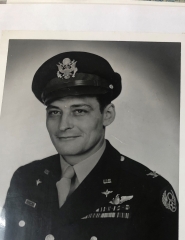Everett W. Stewart

Everett W. Stewart
EVERETT
W.
STEWART
SOLDIER DETAILS
BIOGRAPHY
Everett Wilson Stewart attended Kansas State College and was commissioned a 2d LT through the Army ROTC program on May 30, 1938, and then enlisted in the Aviation Cadet Program of the U.S. Army Air Corps. He began his flying career immediately after graduation from the Army Air Corps Flying School at Kelly Field in San Antonio, Texas. He was commissioned a 2d LT in the U.S. Army Air Corps and awarded his pilot wings on May 26, 1939. Stewart's first duty was in Louisiana, then California, then Hawaii. On December 7, 1941, the Japanese attacked Pearl Harbor as well as the air field where Stewart was stationed. In his account of that day, he stated that he could see his plane from his apartment window and it was on fire. Stewart achieved the rank of Major while he served with a pursuit squadron in Hawaii and on Midway until September 1942 when he returned to the U.S. for further training, flying the P-47 Thunderbolt.
Stewart took command of the 328th Fighter Squadron in April 1943, and deployed with the unit to England in July 1943. His job was to protect the allied bombers as they made their way across France and Germany. He was promoted to full Colonel at age 28. Stewart became deputy commander and then commander of the 355th Fighter Group in 1944 before commanding the 4th Fighter Group in England, the US outfit that shot down the greatest number of German Planes in the European theater. His combat record included 180 missions, approximately 3,500 hours of flying time, and he was credited with 10.5 victories.
After the war, Col. Stewart was assigned to Occupation duty at Headquarters U.S. Air Forces in Europe at Wiesbaden, Germany from September 1945 to March 1946. He served as an Operations and Training Staff Officer at Maxwell Field, Alabama, from May to December 1946, and then at Tyndall Field, Florida, from December 1946 to August 1947. After completing Air Command and Staff School at Maxwell AFB, Alabama, Col. Stewart served as an instructor and director with the Air Tactical School at Tyndall AFB, Florida, from June 1948 to October 1950, followed by service as a director at Air Command and Staff School at Maxwell AFB from October 1950 to July 1951. He attended Air War College from July 1951 to June 1952, and then served with Headquarters U.S. Air Force in the Pentagon until August 1953. His next assignment was on the Joint Intelligence Group in the Office of the Joint Chiefs of Staff in the Pentagon from August 1953 to August 1956, followed by National Defense College in Canada from September 1956 to July 1957. Col. Stewart was Vice Commander of the 30th Air Division at Willow Run AFS, Michigan, from August 1957 to January 1959, Deputy for Operations for the 37th and then the 30th Air Division at Truax Field, Wisconsin, from January 1959 to May 1960, and then Vice Commander of the 30th Air Division, also at Truax Field, from May to October 1960. He served on the staff with Supreme Headquarters Allied Powers Europe at Louveciennes, France, from October 1960 to September 1962, and then served as Senior Air Force Advisor to the 136th Air Defense Wing at USNAS Dallas, Texas, from October 1962 to October 1964. His final assignment was at McConnell AFB in Wichita, Kansas, where he retired from the Air Force on February 1, 1966.
 Eisenhower Foundation
Eisenhower Foundation
